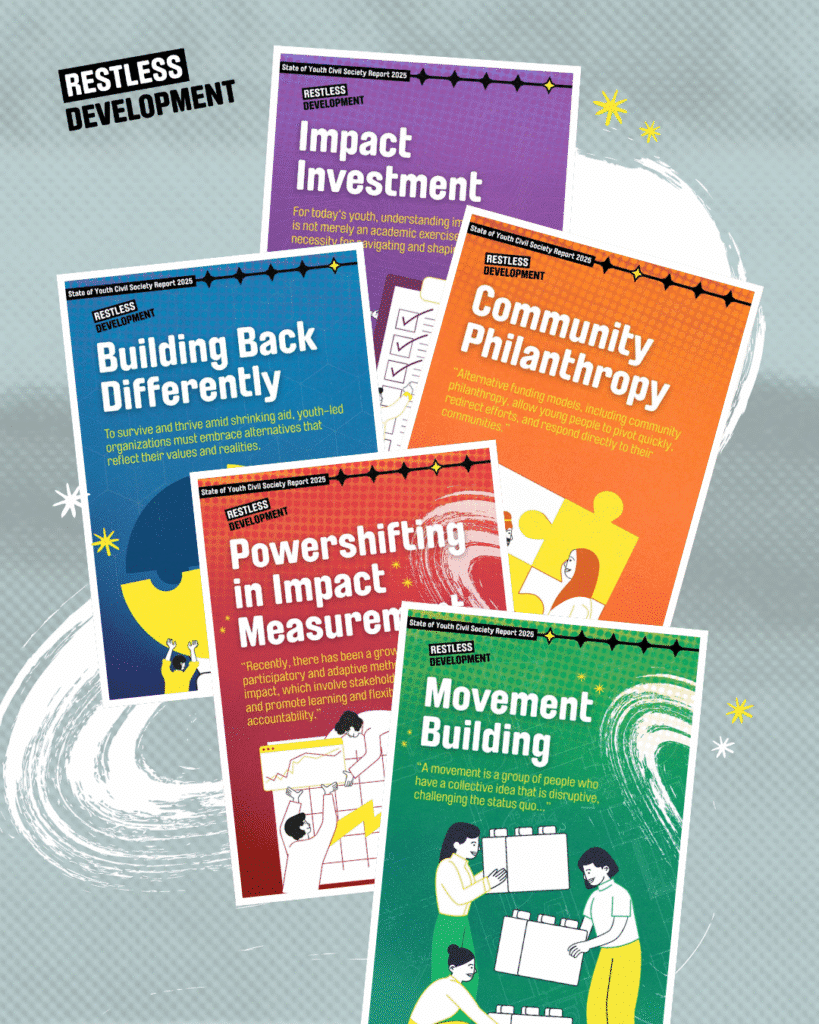In the 2024 State of Youth Civil Society report we introduced the 10 Principles for Funding Youth Movements, a milestone in our collective efforts to ensure sustainable support for youth-led organising. But the development landscape has shifted dramatically since then. The dismantling of USAID has led to the termination of nearly 5,800 multi-year aid awards, a 92% cut in its global programming portfolio. The UK is scaling back its ODA commitment to just 0.3% of GNI by 2027, and the Netherlands plans to reduce its development assistance by €2.4 billion over the same period. These funding reductions disproportionately affect the very sectors that youth civil society depends on – gender equality, education, climate justice, and civic participation.

But, in true Restless Development spirit, we are choosing hope over despair. This year’s report is about reimagining resilience. We have explored how youth civil society can flourish outside traditional funding systems via five practical chapters:
- Movement Building – What are movements, and how do they grow organically? We explore how they persist not because of international funding, but often in spite of it, and what alternative forms of financing they’re already tapping into. (Authored by Maria Malomalo)
- Community Philanthropy – Is community philanthropy the way forward? We unpack how communities have long supported each other through financial resources, goods, and services, and whether this model can work for youth organising. (Authored by Maria Malomalo)
- Impact Investment – What is impact investment? Where is it working, and for whom? We explore its language, power dynamics, and whether it needs a rebrand. (Authored by Dr Souvik Pyne)
- Powershifting in Impact Measurement – How can we shift from donor-centric metrics to community-defined success? Trust, reputation, and shared values often matter more than audited accounts, and we explore how we can legitimise these as valid indicators. (Co-authored by Sharon Manenji and Dennis Mwesigwa)
- Building Back Differently – What does “building back differently” look like for philanthropy? We explore how we can reshape language, practice, and power dynamics to serve youth-led change. (Authored by Chintu Masanta)
Chapter One: Movement Building
Movements have historically been at the forefront of driving change, serving as powerful vehicles for mobilising young people to challenge the status quo and reimagine more just and equitable societies.
Chapter Two: Community Philanthropy
Alternative funding models, including community philanthropy, allow young people to pivot quickly, redirect efforts and respond directly to their communities.
Chapter Three: Impact Investment
For today’s youth, understanding impact investing is not merely an academic exercise but a practical necessity for navigating and shaping tomorrow’s economy.
Impact Investment
A revolutionary approach that seeks to generate positive, measurable social and environmental impact alongside financial returns.
Read the chapterChapter Four: Impact Investment
By making evaluations and impact measurement techniques flexible, inclusive, and driven by those most affected, we get a more honest and powerful picture of what’s working and what needs to change.
Powershifting In Impact Measurement
Getting a more honest and powerful picture of what’s working and what needs to change
Read the chapterChapter Five: Building Back Differently
To survive and thrive amid shrinking aid, youth-led organisations must embrace alternatives that reflect their values and realities.
Building Back Differently
Building back differently calls for a shift from compliance-driven funding to trust-based, decentralised, and sustainable resourcing models
Read the chapter